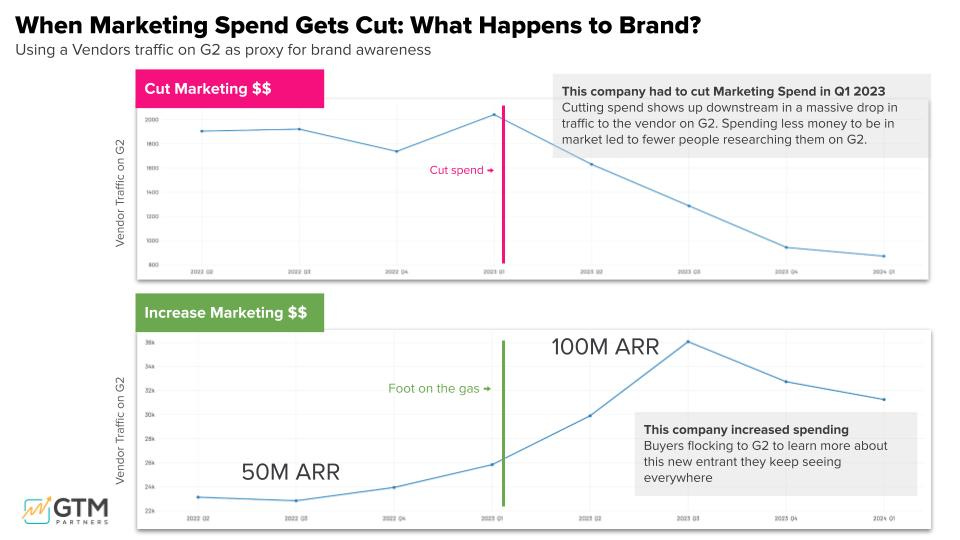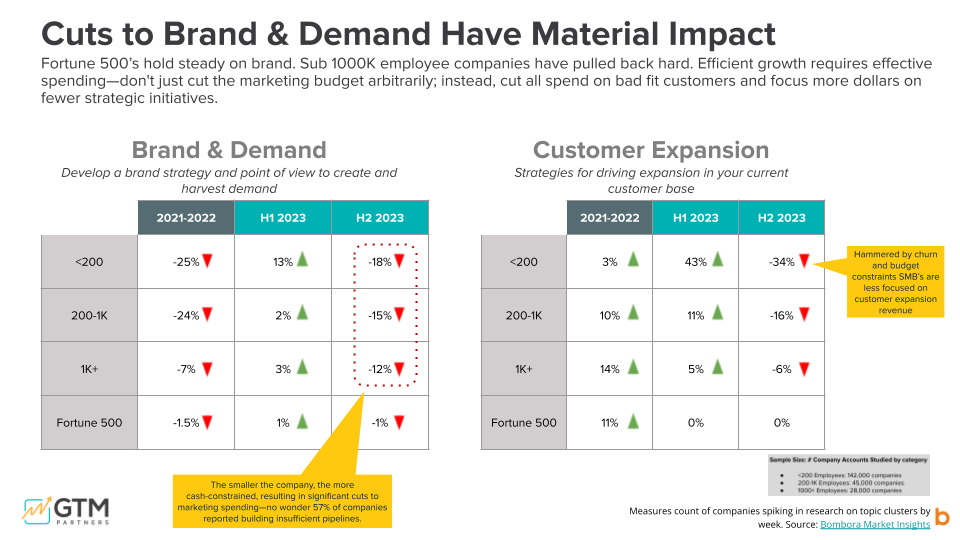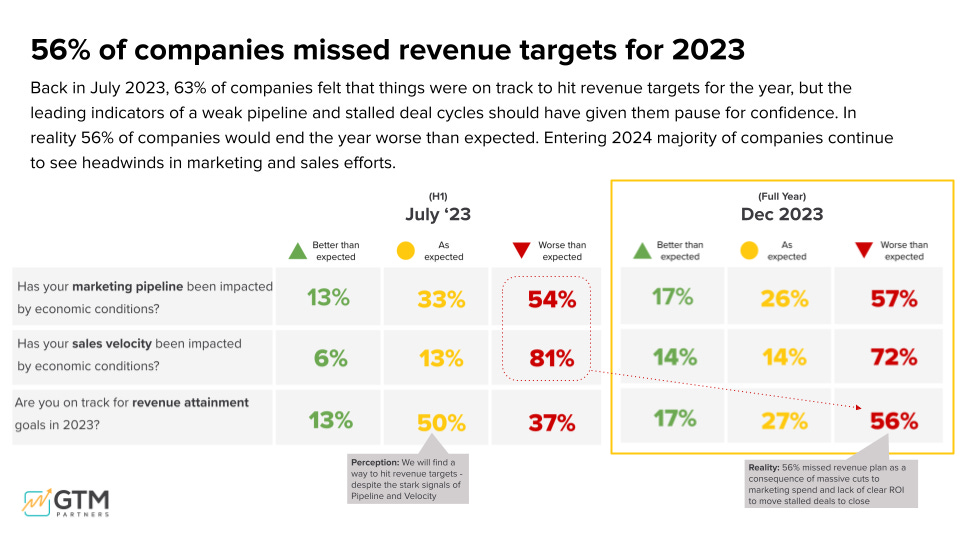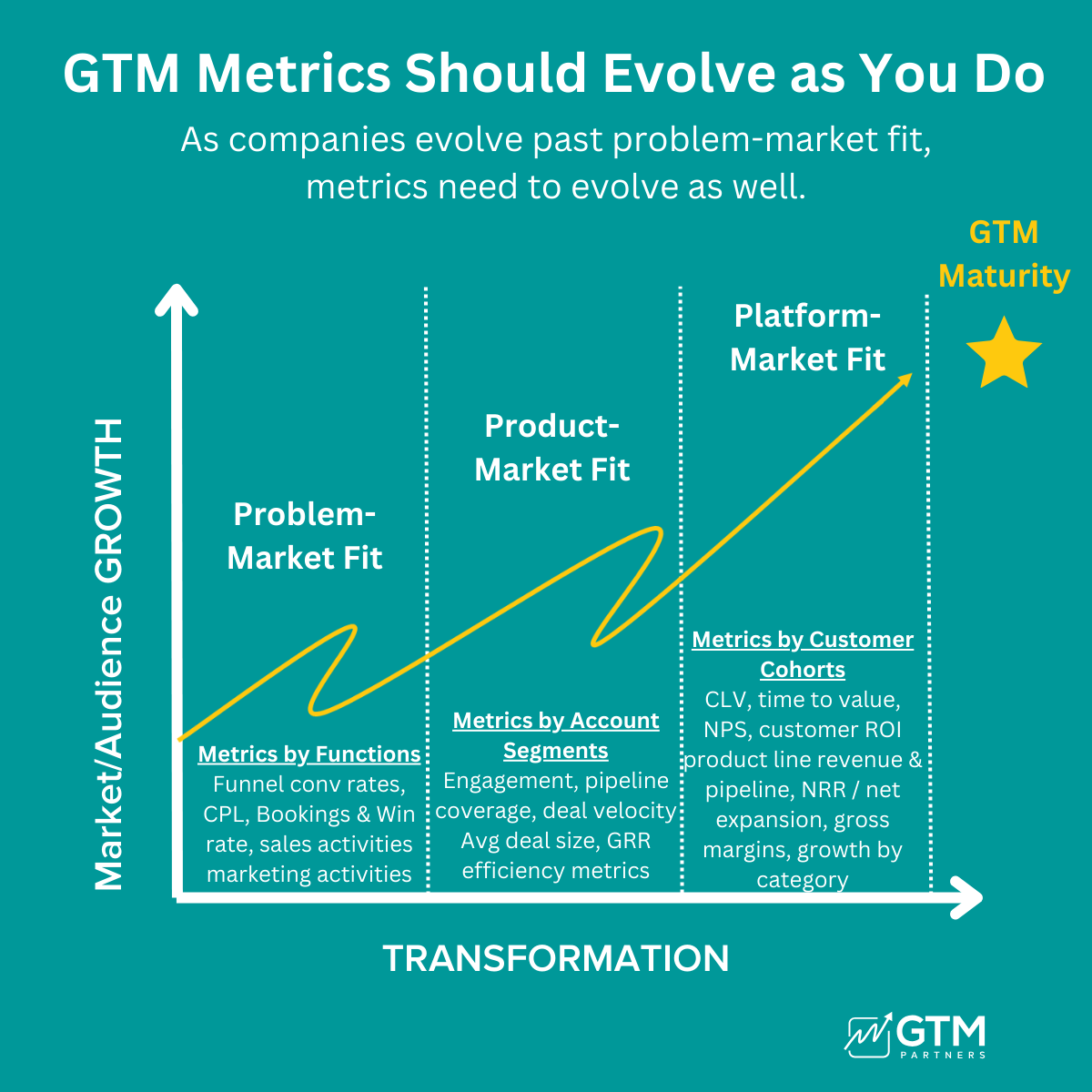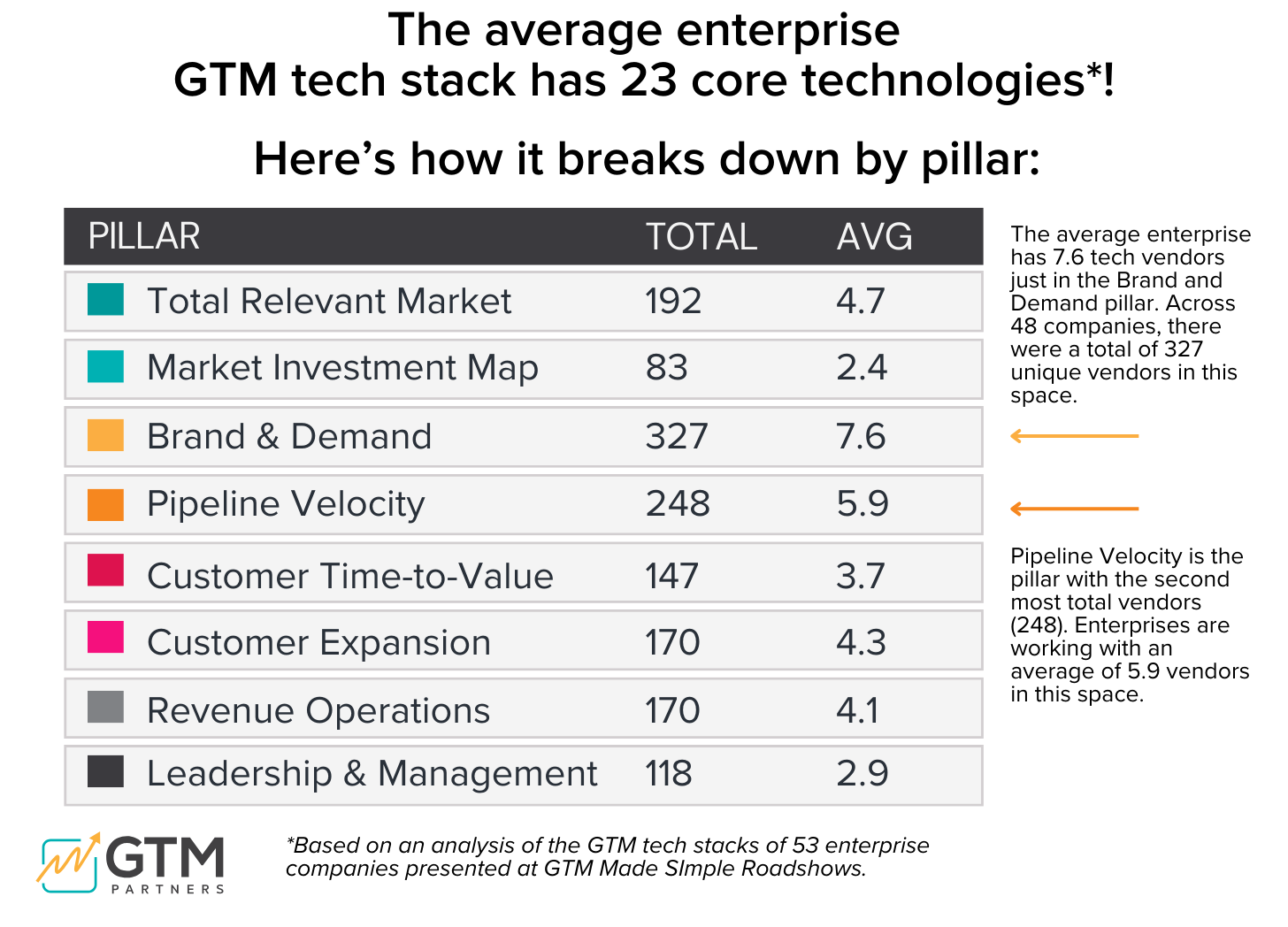Filters
New research: when brand suffers, revenue suffers
Thanks for being one of 49,000 forward-thinking GTM Leaders who subscribe to this weekly research note. We aim to be the go-to for go-to-market, so we appreciate you reading and sharing when you see something you like!
This week’s research note includes:
GTM Research: Efficient growth requires strategic cuts
GTM Problem of the Week: What kind of marketer makes the best CMO?
GTM Research:
A weekly deep-dive into new GTM research and insights
We’re back with more insights from our newly-released GTM Benchmark. That puppy is so rich with data, we could write about it for months in a row! If you see Bryan Brown at a roadshow or in a Zoom room, tell him you dig his benchmark!
We want to talk more about efficient growth. It’s more than just a trend. It’s a necessity. And this won’t be the last time we talk about it.
Unfortunately, on the path to efficient growth, too many CEOs and CFOs have, out of necessity, made massive cuts and layoffs because they didn’t know what else to do. But when cuts are done arbitrarily and without strategic focus, you can get caught in a death spiral with worse performance which leads to more cuts, and on and on.
Our research shows that cutting budgets arbitrarily is a huge mistake.
Instead, cut spending on bad-fit customers and under-performing segments and focus MORE dollars on strategic initiatives that are delivering results.
For example:
After a cut to CS, instead of reallocating remaining CSMs to the same book of business, prioritize accounts with the most potential.
After SDR’s have been cut, don’t have the remaining SDRs pitching the same target account list. Narrow and focus the list.
A reduced marketing department cannot support the same number of products, segments, audiences, and markets.
Let’s dive in.
What the Data Tells Us: Cutting Marketing Hurts Brand and Revenue
Seems obvious right? But we’ll show you the data.
Lets start with an analysis of two companies.
Company #1 had to cut marketing spend in Q1 2023 across the board: slashes to marketing activities like advertising, ABM, events, content, demand gen and more.
Almost instantly, buyer consideration plummeted on G2 from 1900 searches per quarter to less than 900.
They cut marketing.
Fewer buyers were aware.
Sales plummeted.
This is exactly what we should expect to happen when we take our brand out of market, but specific examples always help!
Meanwhile, company #2 started investing MORE in marketing.
They increased spending on demand gen, content, events, ads, etc.
Buyers started flocking to G2 to learn more about this new company they kept seeing so much about.
As a result of the attention, their revenue DOUBLED from $50M ARR to $100M ARR in one year.
Broader trends
When we look back to the GTM Benchmark (page 19), we see that while Fortune 1000 companies have maintained fairly consistent marketing activity, smaller companies have struggled. The smaller the company, the more cash-constrained they tend to be, resulting in significant cuts to marketing spending.
No wonder 57% of companies reported building insufficient pipelines; they weren’t fueling it with marketing!
A cautionary tale with a happy ending
This is a real example we heard last week, anonymized to protect the innocent.
The ABC Company offered a point solution for finance teams. But the CEO and the board didn’t want to be a point solution, they wanted to be a platform company and offer a host of related solutions to finance teams.
They got funding, acquired a bunch of other companies, and created a portfolio of seven product lines in order to become the platform company of their dreams.
But it wasn’t working.
So the board eventually put their foot down. They insisted the ABC company cut spending 50% to survive. The board’s idea was to pull out of the U.S. market and focus on the full platform strategy only in EMEA.
But the clever GTM team did some analysis.
Of the seven product lines, only three were making revenue. The other four product lines weren’t having any success at all.
The three successful products were all related to the point solution for finance teams they were originally known for!
The three successful products were working in both EMEA and North America.
70% of R&D was directed at the four product lines that were failing, while only 30% was directed at the three “successful” products.
So the board’s idea to double down on all seven product lines in EMEA (including four that were failing) while cutting products that WERE working in North America shows what happens when you’re not aligned around a cohesive GTM strategy.
With the right data, the GTM team was able to justify a pivot:
Redirect 95% of R&D into the successful point solutions, which were lagging behind competitors because of three years of neglect.
Redesign the messaging and website to reflect the core capabilities of the point solution rather than the broader platform.
All marketing dollars were diverted to promoting the successful point solutions in both North America and EMEA.
Reduction of investment in the four failing product lines in both North American and EMEA.
In the end, they made massive budget cuts, but they cut it in the right place.
The company’s revenue is up, and they’re having success. It’s more focused success.
You could even argue that this crisis forced them to an important decision point that changed the course of their company for the better.
A more famous example . . .
In 1997, a formerly-ousted CEO re-joined a tech company that had more than 350 products, many of which struck him as redundant, expensive and outdated.
In order to get the company focused on making better products that made more sense to consumers, he cut the number of products down to 10!
In the next decade, the company grew from $7B to $24B.
That CEO was Steve Jobs and the company was Apple.
Or look at our Hubspot example from a few weeks ago.
A company can find focus through leadership or financial necessity. Either way, focus can be funneled towards meteoric success.
The takeaway
Budgets are going to get cut.
Hard decisions are going to need to be made.
If you make hard decisions guided by and aligned to an overall GTM strategy, they won’t feel quite as painful and don’t have to completely stunt revenue. In fact, they could actually propel your growth in new ways you never could have imagined.
GTM Problem of the Week
Send us your most pressing GTM problem, and you’ll get a short session with an analyst to answer it!
Dear GTM Partners,
We’ve had to let go of our CMO and I’m looking for a great-fit candidate. Do you recommend marketers with a brand background or a demand-gen background? And do you have any individuals you can recommend?
Thanks,
CEO in Silicon Valley
Dear CEO in Silicon Valley,
We will hit you up privately with some names of great marketers we know who might be available.
But in the meantime, the kind of CMO you need depends a lot on your company, goals, and GTM strategy. Here’s how we look at CMO backgrounds:
Brand Marketers
Brand marketing is all about the long game. It's about nurturing the company reputation, building trust, and creating lasting customer relationships.
A strong brand can make people loyal for life, which means long-term value. Plus, it sets you apart from the competition and gives you that unique identity.
Consistency is key too, keeping that messaging on point across all teams and silos. When the going gets tough, brand marketers are the reputation saviors, helping you weather the storms.
They also tend to be strong at forging strategic partnerships that can open up new horizons.
The CMO is a strategic role, and a brand marketer has the perfect skills to make sure that the marketing strategy is meeting overall corporate goals at the highest level.
Demand-Gen Marketers
Do you want immediate impact and leadership that values agility, experimentation, and data? Demand gen marketers are leaders who know how to adapt quickly and stay competitive.
Demand gen is all about revenue boost – identifying, attracting, engaging, and converting best-fit prospects into paying, renewing, expanding customers.
Demand gen is the money-maker, and a good demand-gen marketer can measure their impact on the board-level metrics that matter: ARR, NRR, and pipeline.
Demand gen marketers are also experienced at working well with other teams (sales, customer success, product) to make sure goals and messaging are aligned.
Since a CMO is tasked first and foremost with prioritizing strategies that directly contribute to the bottom line, a demand gen marketer is the perfect person for the job.
Product Marketing
You didn’t mention product marketers in your note, but we’d like you to consider them. Product marketers are the market whisperers.
They understand the market, specific customer segments, and the needs of every persona. They tend to keep tabs on the competition and bring back intel that allows a company to make strategic moves.
Product marketers are often the architects of winning go-to-market strategies, figuring out the right messaging and pricing and weighing in on motions and channels.
Product marketers also put their fingerprint on sales activation, enablement, and customer education. They bridge the gap between what customers want, what sales says you have, and what you actually offer.
A CMO with a product marketing background would be well-equipped to align the roadmap, the messaging, and the strategy-to-market needs. Not to mention, effective product marketing can drive revenue growth by identifying opportunities for product expansion, upselling, cross-selling, and optimizing pricing strategies.
Each one brings its own flavor to the table, but in the end, it's all about what serves your business goals best.
Hope that helps, but we are always here to pitch in if you need us!
Send in your GTM Problem of the Week.
We solve GTM problems like this every single day!
Book a call to learn more about how we can help.
GTM News
GTM news, nuggets, announcements, and what we’re reading.
GTMarketplace: Just in case you missed it, last week we launched our new marketplace of agencies and fractional leaders who have been trained and certified in the GTM Operating System.
From Scott Barker’s GTM Newsletter: help on closing enterprise deals.
Ask Amanda from Pavilion is an advice column for you to anonymously submit questions about the soft skills and hard topics you need to master as a go-to-market leader.
Paul Gibson, SVP of Demandbase shares his ideas on how to grow a high-quality pipeline in Demand Gen Report.
GTM Events
A list of upcoming events of interest to GTM professionals
April 17, NYC and virtual: Goldenhour
April 17, NYC: GTM Partners Analyst-Led Dinner with Demandbase and Reachdesk
April 18, NYC, Pavilion CMO Summit
April 25, 1 p.m. Virtual: Rev Ops Leadership Summit
May 10, Seattle, WA: GTM Made Simple Roadshow
May 15-16, St. Louis, MO: Gainsight Pulse
June 7, Atlanta, GA: GTM Made Simple Roadshow
We had a great time seeing many of you last week in Salt Lake City. Hope you enjoyed the therapy and granotela! (IYKYK)
Love,
The GTM Partners Team

